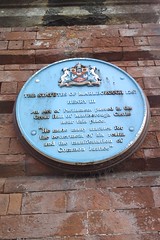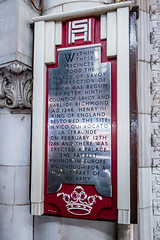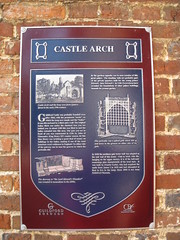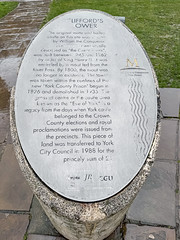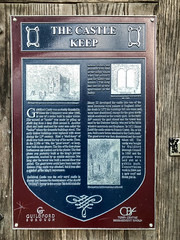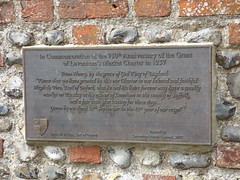King Henry III of England
Commemorated on 8 plaques
The Statutes of Marlborough 1267, Henry III. An Act of Parliament passed in the Great Hall of Marlborough Castle near this place. "He made many statutes for the betterment of his realm and the manifestation of Common Justice"
College Gates, Bath Road, Marlborough, United Kingdom where they made the The Statutes of Marlborough, an Act of Parliament passed in the Great Hall of Marlborough Castle near this place (1266)
Within these precincts stood the Palace of Savoy, the erection of which was begun by Peter, ninth Count of Savoy and Earl of Richmond, A.D 1246. Henry III King of England bestowed the site "in vico qui vocato la straunde" on February 12th 1246 and there was erected a palace, "the fayrest mannor in Europe" big enough for a large part of an army
Savoy Court, London, United Kingdom where they bestowed the site "in vico qui vocato la straunde" (1245)
Guildford Palace The ruins you can see nearby are the remains of what was once one of the most luxurious royal residences in England. Guildford Castle was probably founded by William the Conqueror soon after 1066, with its prominent "motte" or mound with "bailey" to one side, enclosed by a ditch and a wall. The original bailey ditch seems to have run near the spot where you are now standing, until it was filled in when the bailey was extended to Quarry Street in about 1200. Here in the bailey there would originally have been timber buildings to house the garrison. These would have been replaced with stone during the 12th century and subsequently Henry III lavished a great deal of money on buildings and decorations here. The ruin to your right may well have been the King's Great Chamber, his private quarters when staying at Guildford. We know from Exchequer records that the chamber was panelled with wood, there was glass in the windows and the ceiling was decorated with moons and stars. The king had his own chapel nearby, as did the queen. Henry's wife, Eleanor of Provence, was a highly cultured woman who introduced colonnaded gardens and tiled pavements at Guildford. The life of the castle revolved around the Great Hall, which probably lay where the Victorian brick houses now stand. Nearby buildings would have accommodated the royal children, the officials, courtiers and servants who attended the royal family. After Henry III's death in 1272 the palace buildings were used less frequently and eventually allowed to fall into decay.
Castle Hill, Guildford, United Kingdom where they lavished a great deal of money on buildings and decorations here
Castle Arch Guildford Castle was probably founded soon after 1066, with the prominent "motte" on which the keep now stands and the "bailey" to one side enclosed by a ditch and a wall. The original bailey ditch extended into this area. The gate you see in front of you was constructed in 1256 by John of Gloucester, King Henry III's master mason. At this time Henry was lavishing a great deal of money on buildings in the bailey, making it one of the most luxurious royal residences in England. On either side of the gateway can be seen the grooved in which the portcullis slid. In the gardens opposite can be seen remains of this great palace. The standing walls are probably part of the private quarters built for the young prince Edward - later Edward I - in 1246. Excavations have revealed the foundations of other palace buildings beneath the present garden. In 1630 the northern gate tower was adapted as the end wall of this house. Clad in bricks with tile-hanging on the upper storeys, it is of the hall-and-crosswings plan characteristic of the local style. It was built by Francis Carter, who had acquired the castle from James I in 1610 and had attempted at first to live in the keep. Since 1898 it has been Guildford Museum.
Castle Hill, Guildford, United Kingdom where they lavished a great deal of money on buildings in the bailey, making it one of the most luxurious royal residences in England (1255)
Clifford's Tower. The original motte and bailey castle on this site was erected by William the Conqueror. The present tower usually described as "the Great Tower", was built between 1245 and 1262 by order of King Henry III. It was encircled by a moat fed from the River Foss. By 1800, the moat was no longer in existence. The tower was taken within the confines of the new 'York County Prison' begun in 1826 and demolished in 1935. The grassed centre of the castle area known as the "Eye of York" is a legacy from the days when York castle belonged to the Crown. County elections and royal proclamations were issued from the precincts. This piece of land was transferred to York City Council in 1988 for the princely sum of £1.
Tower Street, York, United Kingdom where they ordered the building of the Great Tower (1244-1261)
Guildford Castle was probably founded by William the conqueror soon after 1066, as one of a series built in major towns. The mound or ‘motte’ was made by pulling up chalk dug from a deep ditch around it. Another ditch and bank enclosed the outer area called the “bailey” where the domestic building stood. The early timber buildings were replaced with stone during the 12th century. First a ‘shell-like’ of chalk was built around the top of the motte. Then, in the 1130s or 40s, the ‘great tower’, or keep, was built in two phases. The line of the first-phase battlements are marked out in plaster. The first phase was probably built as the king's private apartments, reached by an outside staircase. Not long after the tower was built a second floor was added. The great tower could have been used for defence if the castle was attacked, but it was also a symbol of the kings importance. Guildford Castle was the only royal castle Surrey and became the headquarters of the sheriff the king’s deputy in the county. He held trials for serious crimes, and prisoners were held the keep, which was the county gaol for Surrey and Sussex. The king had moved to new apartments the bailey. Henry III developed the castle into one of the most luxurious role palaces. in England. After his death in 1272 buildings fell into ruins and were later abandoned, except for the great tower which continued as the county gaol. In the early 16th century the gaol closed and the tower was used by the Daborne family, who put in the brick window surrounds and fireplaces. In 1611 James I sold the castle estate to Francis Carter. He, or his son, built a new house attached to the Castle Arch. The great tower was then abandoned and then roof taken off. The castle was bought by Guildford Borough Council 1885 and the grounds were laid out as a public park. Conservation work in 2004 saw a new roof and floors put in.
Castle Street, Guildford, United Kingdom where they was
In Commemoration of the 750th anniversary of the Grant of Lavenham's Market Charter in 1257 From Henry, by the grace of God King of England: "Know that we have granted by this our Charter to our beloved and faithful Hugh de Vere, Earl of Oxford, that he and his heirs forever may have a weekly market on Tuesday at his manor of Laneham in the county of Suffolk, and a fair each year lasting for three days ... Given by our hand 15th September in the 41st year of our reign" Arms of de Vere, Earl of Oxford Erected by Lavenham Parish Council, 2007
Market Place, Lavenham, United Kingdom where they granted a charter (1257)
The Earl of Richmond. On August 21st 1485, Henry Tudor, Earl of Richmond, having received Mass at Merevale Abbey, is reputed to have slept at an inn on this site named The Three Tuns. Upon his bloody victory over Richard III at the battle of Bosworth the following day, Henry Tudor, Earl of Richmond was was crowned Henry III King of England.
93 Long Street, Atherstone, United Kingdom where they stayed (1485)


